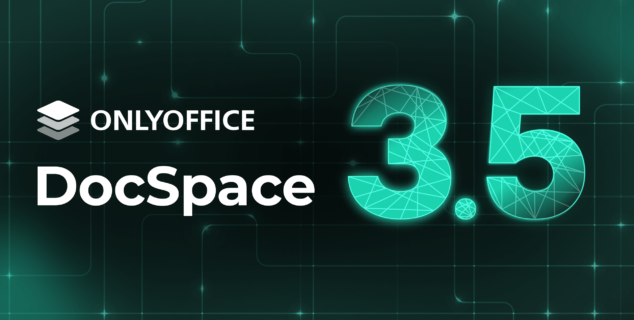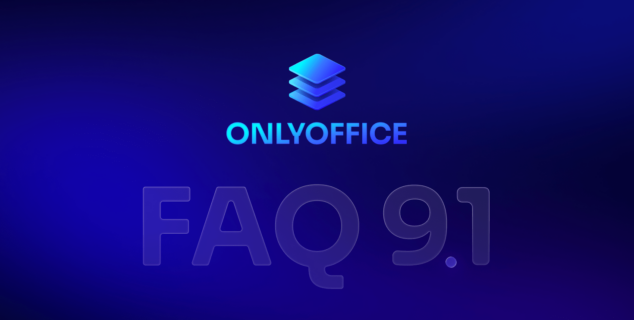From concept to release: a deep dive into ONLYOFFICE Docs 9.0 with the dev team
ONLYOFFICE has long been a stalwart in the collaborative office software industry, continually adapting to user needs and advancing technology. The release of ONLYOFFICE Docs 9.0 brings significant updates, from a redesigned interface to extended file compatibility and cutting-edge AI-powered features.
To gain insight into the vision and effort behind this update, we interviewed Alex, Head of the Docs Development Team at ONLYOFFICE.

General vision & inspiration
Q: What was the driving vision behind the development of ONLYOFFICE 9.0, and how does this release align with your long-term goals for the platform?
A: I believe the strength of a close-knit team, which has been dedicated to this product for over 15 years since its inception, played a crucial role. Additionally, with version 9.0, we undertook a complete interface overhaul. This significant challenge required immense effort and collaboration across the entire team.
Q: Can you share an instance where user feedback heavily influenced a feature in this update?
A: We consistently review the most popular features to set development priorities for future versions. RTL support has been one of the most highly anticipated updates among our users. Additionally, there has been significant demand for adding support for the Markdown format which seamlessly integrates with AI-powered tools to enhance content creation, streamline workflows, and enable efficient collaboration through structured and easily interpretable text formatting.
Quick tip: Have any suggestions for ONLYOFFICE? Share them with us via feedback.onlyoffice.com. Your input matters!
Q: What were some of the biggest challenges the team faced during the development of this version, and how did you overcome them?
A: The interface update was a massive undertaking, involving collaboration from a wide range of employees across various teams and departments. Additionally, the preliminary approvals for the concept itself spanned over six months.
Redesigned interface
Q: The redesigned interface prioritizes clarity and ease of use. What inspired these changes, and how do you think they will benefit users in their daily workflows?
A: It had been quite some time since our last major interface overhaul. In this update, we aimed to incorporate the latest trends and technologies while ensuring we preserved the familiar experience for our long-time users. As part of this effort, we had to redraw 3,000 icons to align with the new design while maintaining the essence of the original interface.
Q: Were there specific design principles or trends you followed while revamping the interface across all editors?
A: We made a conscious effort to incorporate the latest innovations in both design and development. Our goal was to create an interface that feels modern and intuitive while maintaining functionality and ease of use. We focused on clean aesthetics, improved accessibility, and seamless navigation to enhance the overall user experience. By staying aligned with current design trends, we ensured that the interface not only meets but exceeds the expectations of our diverse user base.

Introduction of the Diagram Viewer
Q: Can you walk us through why the Diagram Viewer was introduced and how it enhances usability for users working with complex visuals?
A: Office files often contain OLE objects, such as Visio diagrams, which previously couldn’t be viewed without additional functionality. By implementing this feature, we’ve made it possible to seamlessly access these visuals. This addition also allowed us to address another important niche in the office software market.
Adding the Diagram Viewer reflects our commitment to providing a seamless and flexible user experience. This decision was driven by the capabilities of OOXML and the growing demand from users for comprehensive support of complex formats. By ensuring compatibility across multiple platforms, we empower users to work with Visio diagrams effortlessly, regardless of their device or environment.

Extended file format compatibility
Q: ONLYOFFICE now supports more file types, including Markdown and Visio files. What led to the decision to prioritize these formats in this update?
A: The decision to prioritize these formats was driven by their growing popularity in the market and consistent user demand. Markdown has become a widely adopted format for content creation, such as documentation pages and README files, while Visio files remain essential for professionals handling complex diagrams. Previously, we offered a Markdown plugin for DocSpace users, which had its limitations. However, with the rising popularity of Markdown fueled by the growing integration of AI in content creation and collaboration, we decided to introduce native Markdown support to meet evolving user needs.
Q: Could you share the challenges you faced with maintaining quality and formatting while integrating diverse file types?
A: Since we don’t rely on third-party libraries for handling these formats, we develop the entire functionality from the ground up, ensuring full control over quality and performance.

AI-powered enhancements
Q: The inclusion of AI-powered tools in spreadsheets and macros is a major highlight. What inspired these additions and how do you see AI transforming document workflows?
A: Our primary goal in integrating AI technologies into the product is to simplify document workflows and save users valuable time. Additionally, we offer a variety of AI tools, ensuring flexibility and avoiding reliance on a single solution.
Q: The OCR feature for PDFs is a game-changer. How did you ensure its accuracy and usability during development?
A: Thorough testing and fine-tuning prompts are key pillars of the development process.
Q: Automation is a key theme in this update. How is ONLYOFFICE planning to expand AI capabilities in future versions?
A: We aim to enhance integration with document context and enable users to customize the workflow between AI processes and the final output.

PDF Editor upgrades
Q: Collaborative PDF form editing is a standout feature. What industries or user scenarios do you see benefiting most from this?
A: PDF, alongside OOXML, is a cornerstone format for office documents. While many tools offer PDF viewing, only a select few provide robust editing capabilities. By introducing the mentioned feature, we not only addressed the needs and workflows of our existing users but also attracted a broader audience to our product.
Q: The drag-and-drop page reordering is a simple but impactful upgrade. How do you determine which small optimizations will have the biggest effect on user experience?
A: There is a core set of essential functionalities that users expect in our PDF Editor to ensure a seamless and convenient experience. This feature is a key part of that foundation.
Q: How did user requests shape the PDF Editor tools like page copying shortcuts?
A: Before each release, we conduct thorough functional testing to evaluate how users interact with and perceive each feature. Additionally, we ensure the product aligns with the standard behaviors users are familiar with from other tools.

Document Editor and other enhancements
Q: With enhanced content controls and paragraph borders in the Document Editor, external data selection in spreadsheets for managing large datasets, and support for text animations in presentations, what drove these updates, and how do they collectively enhance efficiency, creativity, and user experience across the platform?
A: We strive to consider all user requests, carefully evaluating both the demand and implementation costs for each feature. By introducing the ability to import data from various sources into a single table, we aim to streamline workflows, save time, and ensure data accuracy, enhancing both collaboration and individual productivity. Features like enhanced tools for creating dynamic slides and engaging presentations provide users with greater flexibility and creativity, ensuring a more seamless and impactful experience across the platform.

Localization and accessibility
Q: RTL and localization improvements are crucial for global user accessibility. How do you go about prioritizing and implementing language support?
A: We base our decisions on evaluating the impact of each feature in terms of popularity, usability, and user demand, while also considering the needs of both current and potential users.
Q: What goes into collaborating with contributors for translations, and how do their efforts impact the ONLYOFFICE community?
A: Collaborating with contributors for translations involves a structured yet inclusive process. We provide tools and guidelines to ensure consistency and accuracy while encouraging community members to share their linguistic expertise. Their efforts not only enhance the accessibility of ONLYOFFICE for users worldwide but also foster a sense of ownership and belonging within the community. This collaboration helps us build a truly global product that meets the diverse needs of our users.
Quick tip: Join our community of contributors and translators! Check the details

ONLYOFFICE Docs 9.0: Free webinar & download
Watch our detailed webinar to learn more about the latest update:
Experience Docs 9.0 as a self-hosted build or download the free desktop app today:
Create your free ONLYOFFICE account
View, edit and collaborate on docs, sheets, slides, forms, and PDF files online.


